#floridasprings
Explore tagged Tumblr posts
Text
Swamp Witch Travels: Rainbow Springs
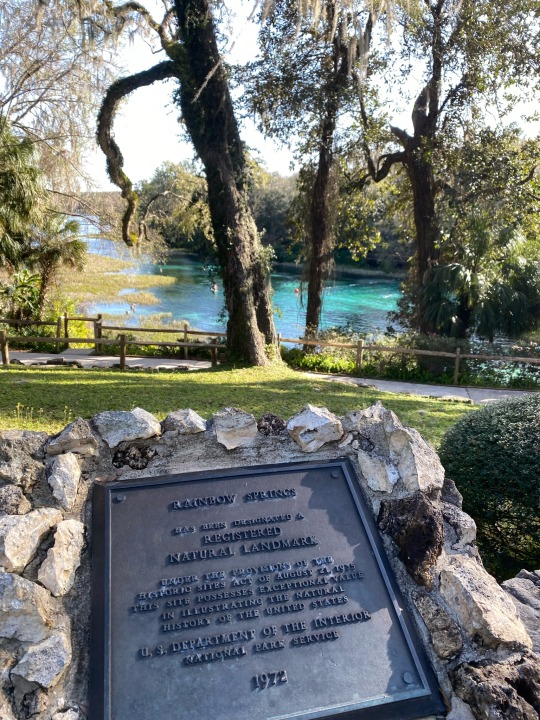

History
Rainbow Springs’ first human visitors probably came upon her waters well over 10,000 years ago in the form of paleo-indigenous groups. Moving further along, the Timucua and their neighbors used this spring, like many others for fishing, travel and funerary rites. After colonization, the area surrounding the spring was used for phosphate mining into the 1930s. This is where much of the waterfalls on the property came from, made with byproduct of the mines. From here, it became a privately owned tourist attraction offering many of the same draws as Silver Springs, like glass bottom boats, submarines and of course a dip in the ‘Healing Waters’. In 1990, the State acquired it, creating the park we have today. Its a first magnitude spring, and the fourth largest in the state. Like many springs, it was formed from a sinkhole around 14,000 years ago and freshwater bubbles up from it continuously.
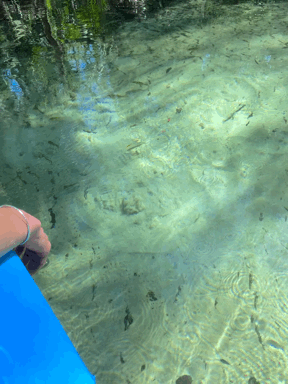
Agua Dulce
Springs have always had a connection to the Indigenous peoples of the area. In the Caribbean, we find amongst the syncretic systems the concept of a group of spirits known by some as the Division of Agua Dulce, which literally translates to Sweet Water. This group of spirits is comprised of Indigenous ancestors who were from the Caribbean or transported there during colonial times. Some of the spirits are fallen heroes, past Caciques, or the Cemí and other Land spirits these ancestors have relationships with. Some of the Spirits in this division I venerate and work with are Atabey, the Supreme Creatrix and Water Mother, and Anacaono, a female Cacique from Ayiti (Haiti) who led a Taino Rebellion in the 16th Century. Within the practices of this division, we see that Springs are held as places of high spiritual importance, and are a direct connection to our ancestors, as their spirit is literally embedded in the Sweet Waters rising from the Spring. The word ‘canoe’ actually comes from the Taíno (kanoa). In espiritismo, one metaphor for the Bóveda I have heard is that it is your own personal Spring of spiritual energy and wisdom, deepening the importance of springs in my practice.
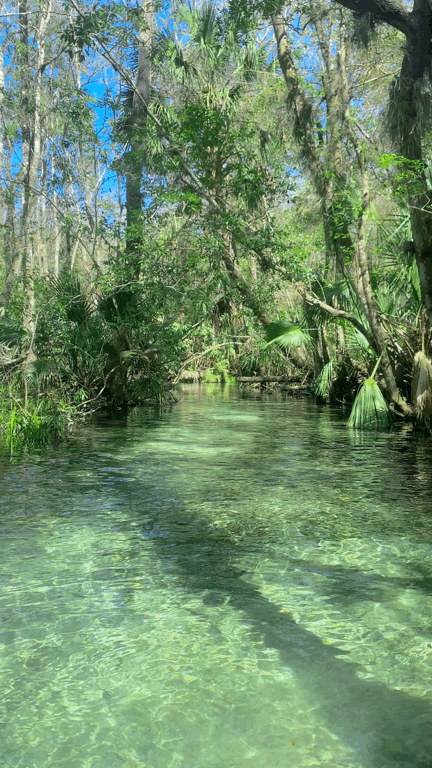
Springs in Praxis
When I visit any park, I always leave an offering by a tree upon entering. I believe in the notion of paying one to pay them all. This is usually tobacco and some coins, accompanied by a prayer. However, when I go to a River or Spring, I find it imperative to also make an offering to the Water itself. This allows me safe entry, and occasionally even some guidance and protection. Like many water spirits, shiny coins and singing make nice offerings to the Springs. Its always good practice to clean up trash and be respectful to the workers and environment. You should always ask permission and make an offering if you plan on collecting anything, as otherwise it may not lend you the virtues you are seeking. When I visit a Spring, I always fully submerge myself - baptism style - to cleanse and receive the healing and blessings of the spring. I also will collect some of the water if I need to use as an offering to certain spirits, as well as for spellwork. I empower the water to either call on the spring itself or for virtues of healing, renewal and growth. I have also heard of friends using the water for prophetic dreams and divination work, citing the connection to spiritual development in espiritismo.
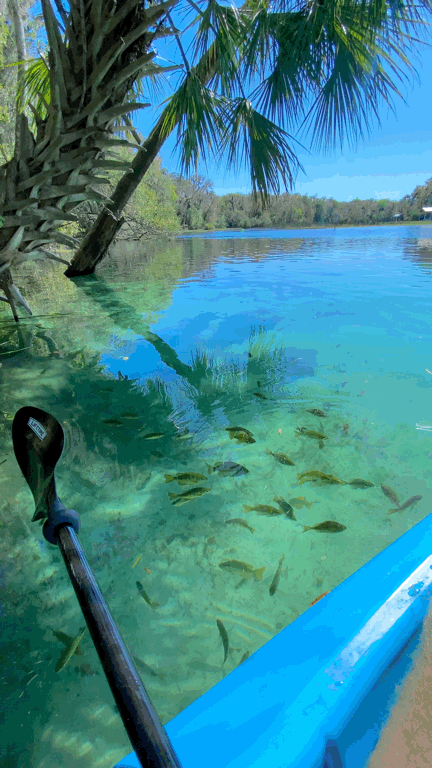
Springs for Tomorrow
Many springs today are suffering various ecological problems, most of which are directly caused by humans. The best spiritual practice is to learn how to act in these sensitive environments, to prevent further degradation. I recommend the instagram @FloridaSpringsCouncil to learn more about the importance of our Springs and the issues plaguing them.
Bendiciones🕯️
#witchcraft#florida#bioregional animism#bruja#brujeria#florida witch#santeria#swamp witch#witch#traditional witchcraft#floridasprings#rainbowsprings#espiritismo#cuban#cubanfolkmagic#cuba
12 notes
·
View notes
Text

Into the VOID. All the magic is on the other side of the abyss ✨ Do you dare dive in? 👽
Artist: Brandon Howard
#art#underwater photography#spirituality#nature#travel#underwaterphotography#underwaterart#floridasprings#floridaphotography#underwaterphotographer#freediving#springs#floridanature#divingphoto#divingphotography#travelphotography#freedive
2 notes
·
View notes
Text
Went to kings landing in FL and it was magical
2 notes
·
View notes
Text
Florida Springs
Florida Springs
0 notes
Text






Here are some pictures I took when I visited Ginnie Springs in August of this year. Make sure to click on “ALT” in each picture to view the descriptions.
1 note
·
View note
Text
A Day at the Springs and the Beach in Central Florida

Escape the ordinary and immerse yourself in the wonders of Central Florida's springs and beaches. Uncover the secrets of this captivating destination while enjoying a day of relaxation and exploration.
0 notes
Photo

A Day at the Springs and the Beach in Central Florida Follow us on a journey to Central Florida's enchanting springs and breathtaking beaches. Experience the magic of this unique ecosystem and gain a deeper understanding of the fascinating wildlife and surroundings.
0 notes
Text
Hop in your kayak and explore some of Florida’s most beautiful springs!
Hop in your kayak and explore some of Florida’s most beautiful springs! 🌊 From crystal clear waters to lush vegetation and wildlife, you’ll get a unique experience each time.
We've rounded up the best spots for kayaking in the Sunshine State - 🗺 including where to go, when to go, and some useful tips.
Hit the water this weekend and explore all that nature has to offer! 🤗
#kayaking #florida #springs #FloridaSprings #KayakingAdventure
0 notes
Text
Weeki Wachee Springs is renowned for its crystal-clear freshwater springs, which have a temperature of 72 degrees Fahrenheit year-round. These springs provide..
0 notes
Note
I have a question? Let’s say if a Cuban spiritualist was from Pinar del Rio and they have indigenous ancestry however sources say the Ciboney Taino inhabited Pinar del Rio and other sources say the Guanahatabey inhabited Pinar del Rio and other sources say both inhabited land, then which source should that person trust? And do we have information on the Guanahatabey spirituality?
Hey! This will be a long answer about Indigenous Caribbean Identity so check below the cut for more!🌺🌴🐠🦜🌀🦩🥭🍋🟩🥥
This is a complex question. I would say the biggest thing to remember is that the term “Taíno” is an umbrella term to reference many different ethnicities of Arawak-Speaking Indigenous Caribbeans. There were many types of Taíno people, including Timucua and Tequesta in Florida, Lucayo in the Bahamas, Ciguayo in Kiskeya and Igneri in Boriken.
As for the term Ciboney, some say it was a separate tribe but the general consensus is that they were a Taíno ethnicity with a separate but mutually intelligible language. They were connected culturally to groups from Jamaica, Florida, Bahamas and modern day Haiti, where as Taínos of the eastern Caribbean were closer in culture. They also had language connections to the Macorix and Guanahatabeys being Waroid languages, aka where we get the term Guajiro. So the Ciboney are a Taino-Arawak group that had ancestrally mixed with the Waroid Guanahatabeys but still maintained moslty Taíno culture.
There were also many other groups who weren’t Taíno. The most well known is the Kalinago, but the Guanahatabey is one from Cuba that is also known to actually have been in Cuba BEFORE the Taínos got there. They had a culture very similar to the Calusa of Southwest Florida. And this is all pre-Colonization, so these groups were already interacting and moving around for thousands of years.
Then with colonization, many Native groups were transported to other places, and in Cuba specifically we have Taíno migrations from the East to the West very early on. We also have Natives from Florida and Mayans from Mexico, and more natives being brought in to cuba and intermarrying with other ethnic groups. These migrations all affected indigenous communities and led to alot of cultural exchange and mixture, as well as loss.
As for Indigenous Cuban Identity, I claim Taíno or Ciboney Taíno because after colonization any remaining Guanahatabeys were assimilated to Taíno Cimarron (maroon/runaway) groups. I consider Guanahatabeys part of my ancestors but I choose to identify as Taíno or simply Indigenous Caribbean. My family all identify as Guajiros, as do I, which is more a lifestyle but definitely has ties to the Classic Taino, Ciboney and Guanahatabey traditions passed down.
As for trusting sources, I would say read EVERYTHING with a grain of salt. Academics often lack cultural nuance and understanding, which can mean alot of their inferences are flat out wrong so try to stick with confirmed info. It is confirmed the Tainos and Guanahatabeys and Ciboneys all moved around and lived in the same parts of the Island at the same time and separately. As for non-academic sources, just be aware that much of what is passed off as Taino or Indigenous Caribbean culture is actually just Pan-Indigenous or straight up a different culture.
Trust yourself, use your intuition and discernment and always be committed to improving and striving for a culturally authentic, fulfilling and respectful practice that is well rounded in both Spirituality and Community! Whether that is with a yukayeke, with the Indigenous tribes you live near locally or with your own indigenous family and friends! So many Yukayekes in the Modern Taíno community try to claim superiority or that they have all the secrets knowledge and the only correct beliefs. You should be weary of anyone trying to restrict you when their own elders often are reconnecting or were just scholars before becoming pop-up Caciques.
If you go to the Cuban version of Wikipedia, when it is active, you can find better information on the Guanahatabey and Ciboney than on American wiki. Try researching the terms ‘Guayabo Blanco’ and ‘Cayo Redondo’ for information on Ciboney culture and beliefs, and how even within this sub-group there were MORE sub-groups. As the Guanahatabeys were not a ceramic culture, we have very little info on them academically. Try researching Calusa beliefs as they had similar environments and were connected through trade routes.
If you have any more questions I would love to answer them but you should ask them on insta or in chat so I can link easier and answer in more depth!!
My asks are always open still tho :)
Luz y progreso
#witchcraft#florida#bioregional animism#bruja#brujeria#florida witch#santeria#swamp witch#witch#traditional witchcraft#taino spirituality#taino#ciboney#indigenous#floridasprings#agua dulce#caribbean#indigenous caribbean#carib#caribe#kalinago#calusa#seminole#native american
7 notes
·
View notes
Link
🚣♀️ The Ichetucknee River in Florida is a hidden gem for kayaking enthusiasts. The crystal clear waters offer a unique experience for those looking to explore the outdoors. 🌳 The river is surrounded by lush greenery and wildlife, making it a perfect spot for nature lovers. The water is so clear that you can see fish swimming beneath your kayak. 🌞 The Ichetucknee Springs State Park offers rentals for kayaks and tubes, making it accessible for all. The park also has picnic areas and hiking trails for those looking to make a day of it. Come experience the beauty of Ichetucknee kayaking!1. Exploring the Ichetucknee River: A Kayaker's ParadiseThe Ichetucknee River is a kayaker's paradise, offering crystal-clear waters and stunning natural beauty. Experience the thrill of kayaking through the river's winding paths and lush vegetation. Spot a variety of wildlife, including turtles, fish, and birds. Take a break and swim in the refreshing springs along the way. Don't have your own kayak? No problem! There are rental options available at the park. Make sure to pack sunscreen, water, and snacks for your adventure. And don't forget your camera to capture the breathtaking scenery! �� Plan your trip during the week to avoid crowds and enjoy a more peaceful experience. 🌞 Remember to respect the environment and leave no trace behind. Let's preserve this kayaker's paradise for generations to come. 🌿2. Crystal Clear Waters of Ichetucknee: A Natural WonderThe Ichetucknee River is a natural wonder with crystal clear waters that attract visitors from all over the world. The river is fed by nine springs that keep the water at a constant temperature of 72 degrees Fahrenheit. The clarity of the water is due to the absence of pollutants and the presence of limestone, which filters impurities. Visitors can enjoy swimming, snorkeling, and tubing in the river, while observing the diverse aquatic wildlife. 🐠🐢🦆 The Ichetucknee River is also a popular spot for kayaking and canoeing, offering a peaceful and scenic experience. 🚣♀️🌳 The river is surrounded by lush vegetation, including cypress trees, oak trees, and Spanish moss. 🌿🌳 Visitors can also explore the nearby Ichetucknee Springs State Park, which offers hiking trails, picnic areas, and campsites. 🏞️🌭🏕️ Overall, the Ichetucknee River is a unique natural wonder that offers a refreshing and unforgettable experience for all who visit. 🌊🌞3. Kayaking in Ichetucknee: Tips for a Safe and Enjoyable ExperienceBefore you go kayaking in Ichetucknee, make sure you follow these tips for a safe and enjoyable experience: Wear a life jacket at all times. Check the weather forecast before you go. Bring plenty of water and snacks. Apply sunscreen and wear a hat. Stay hydrated and take breaks as needed. When kayaking, keep these safety tips in mind: Stay alert and aware of your surroundings. Don't drink alcohol or use drugs while kayaking. Stay away from wildlife and avoid disturbing their habitat. Don't litter. Pack out what you pack in. For an enjoyable experience, consider these tips: Take in the beautiful scenery and wildlife. Bring a camera to capture the memories. Plan your route and know where you're going. Enjoy the peacefulness of the river. Share your experience with friends and family. Remember to always prioritize safety and respect the environment. Have fun! 🚣♀️🌳4. Discovering the Flora and Fauna of Ichetucknee River on a KayakExploring the Ichetucknee River on a kayak is an adventure that allows you to discover the diverse flora and fauna of the area. As you paddle along the river, you'll be amazed by the variety of plant life, including cypress trees, Spanish moss, and water lilies. Keep an eye out for the many species of birds that call the river home, such as the great blue heron, osprey, and bald eagle. Don't forget to look down into the crystal-clear water, where you'll see fish, turtles, and even manatees. Take a break from paddling and hike the trails to spot deer, raccoons, and armadillos. Remember to respect the wildlife and keep a safe distance. Enjoy the beauty of nature and take in the peacefulness of the river. 🌿🦆🐢🌺5. Ichetucknee Kayaking: A Perfect Outdoor Activity for Families and Friends🚣♀️🌳Looking for an exciting outdoor activity to do with your loved ones? Try Ichetucknee kayaking! It's a great way to bond with family and friends while enjoying nature's beauty. 🛶🌊Ichetucknee Springs State Park offers a 6-mile river trail that takes you through crystal clear waters and lush greenery. It's perfect for beginners and experienced kayakers alike. 🌞🌴The park also has picnic areas, playgrounds, and hiking trails, making it an ideal spot for a day trip. Don't forget to bring sunscreen, water, and snacks for a comfortable experience. 🐟🦆As you paddle along the river, keep an eye out for wildlife such as turtles, fish, and birds. The peaceful surroundings will make you feel like you're in a different world. 🏊♂️💦If you're feeling adventurous, take a dip in the refreshing springs. The water is so clear that you can see the bottom, and it's a great way to cool off after a long paddle. 📷🌅Capture the memories by bringing a waterproof camera or phone case. You'll want to remember the beautiful scenery and fun times with your loved ones. 🌟👨👩👧👦Overall, Ichetucknee kayaking is a perfect outdoor activity for families and friends. It's an affordable and enjoyable way to spend quality time together while experiencing the natural wonders of Florida.6. The History and Significance of Ichetucknee River for Kayaking EnthusiastsThe Ichetucknee River is a 6-mile-long river located in North Florida, USA. It is a popular destination for kayaking enthusiasts due to its crystal-clear waters and scenic views. 🛶 The river has a rich history dating back to the Timucuan Indians who lived in the area. It was later used for logging and turpentine production in the 1800s. Today, it is a protected natural area and state park. 🌳 Kayaking on the Ichetucknee River offers a unique experience as the river flows through a lush forest and is home to a variety of wildlife, including otters, turtles, and fish. 🐢 The river's crystal-clear waters are a result of the underground springs that feed it. The water temperature remains a constant 72 degrees Fahrenheit year-round, making it an ideal spot for kayaking even in the summer heat. 💦 The Ichetucknee River is also significant for its role in conservation efforts. The river and its surrounding area are home to several endangered species, including the Florida manatee and the wood stork. 🦩 Kayaking on the Ichetucknee River is a popular activity for both locals and tourists. It offers a chance to experience the natural beauty of Florida and get up close with its diverse wildlife. 🌞 In conclusion, the Ichetucknee River is a must-visit destination for kayaking enthusiasts. Its rich history, crystal-clear waters, and diverse wildlife make it a unique and unforgettable experience. 🌊7. Best Time to Go Kayaking in Ichetucknee: Seasonal Changes and Weather ConditionsWhen planning a kayaking trip in Ichetucknee, it's essential to consider the seasonal changes and weather conditions. Here are some tips to help you choose the best time to go: Spring and Fall are the best seasons to go kayaking in Ichetucknee due to mild temperatures and less crowded conditions. Summer is the peak season, with warm temperatures and high water levels, making it ideal for tubing. Winter is the least popular season due to cold temperatures, but it can be a great time to see wildlife and enjoy the peacefulness of the park. When it comes to weather conditions, it's crucial to check the forecast before heading out. Thunderstorms are common during the summer months, and it's best to avoid kayaking during these times. Always wear appropriate clothing and gear for the weather conditions, including a life jacket and sunscreen. Be aware of the water levels and currents, as they can change rapidly during heavy rainfalls. Respect the park's rules and regulations, including no alcohol and no littering. Overall, the best time to go kayaking in Ichetucknee is during the Spring and Fall seasons, with mild temperatures and less crowded conditions. However, with proper planning and preparation, you can enjoy kayaking in any season and appreciate the beauty of this natural wonder. 🚣♀️🌞🌧️🍂🌳🐊 In conclusion, Ichetucknee kayaking is an unforgettable experience that offers crystal clear waters and stunning scenery. 🛶🌊 The river is perfect for all skill levels, making it an ideal destination for families and friends. 🌳👨👩👧👦 Don't forget to bring sunscreen, water, and snacks for your adventure. 🌞🥤🍎 And be sure to follow the park's rules to preserve the natural beauty of this unique ecosystem. 🌿🌺🐟 Whether you're a seasoned kayaker or a first-timer, Ichetucknee Springs State Park is a must-visit destination for anyone who loves the great outdoors. 🌲🌞🌊 https://xtremesports.net/ichetucknee-kayaking-crystal-clear-waters/?_unique_id=6483b3c53893c
#Uncategorised#FloridaSprings#IchetuckneeRiver#Kayakingadventures#Natureexploration#outdoorrecreation#aiomatic_0
0 notes
Video
youtube
(via Juniper Springs - Best Florida Springs)
0 notes
Text
An Analysis of Florida's Vulnerable Springs
Article Title: Assessing Pollution and Depletion of Large Artesian Springs in Florida's Rapidly Developing Water‐Rich Landscape
Authors: Robert L. Knight and Angeline Meeks
Published in: Threats to Springs in a Changing World: Science and Policies for Protection (Geophysical Monograph 275), 2023.
Publisher: American Geophysical Union, John Wiley & Sons.
Article Link: https://doi.org/10.1002/9781119818625.ch2
Summary
This article chapter assesses how environmental changes and human activity have deteriorated Florida's artesian springs. Deteriorating groundwater levels brought on by excessive pumping and pollution from urban and agricultural runoff are major problems. It highlights its role in managing and restoring these vital ecosystems by introducing the Blue Water Audit (BWA), a GIS-based tool for evaluating the environmental impact of water use and pollution. The results indicate that spring health is still declining despite current conservation efforts.
Rhetorical Analysis
Ethos (Credibility):
Prominent environmental scientist Robert L. Knight, who founded the Florida Springs Institute, has an extensive amount of knowledge about managing water resources and conserving springs. He is more credible because his work is regularly referenced in scholarly publications and discussions of environmental policy.
Another author in the article, Angeline Meeks, is involved in environmental studies that concentrate on the sustainability of aquatic environments. Even though her background isn't as well-known as Knight's, the article is more credible because she co-wrote it with a respected authority. Although her inclusion implies a collaborative approach, probably integrating diverse expertise, more information about her role in this work may become clear as her credentials are further researched.
Pathos (Emotional Appeal):
The narrative emphasizes Florida's springs' ecological and aesthetic value as well as their crucial function in biodiversity. Strong depictions of environmental deterioration, such as native plant replacement by algal blooms, and the possible loss of cultural and recreational heritage associated with these ecosystems are examples of emotional appeals.
Logos (Logical Argument):
Data from decades of hydrological research as well as advanced tools like the BWA form the basis of the argument. It shows a clear connection between ecological decline and human activities (such as nitrogen pollution and groundwater extraction). Recommendations are supported by quantitative analysis, which guarantees logical congruence.
Target Audience
The target audience for this article includes conservation organizations, environmental scientists, and policymakers. Nonetheless, it appears to also strive to reach the knowledgeable public with an interest in environmental advocacy, considering its clear language and use of compelling data visualizations.
Language and Style
The writing maintains a balance between accessibility and technical accuracy. Although phrases like "aquifer footprint" and "eutrophication" are used, definitions are given to guarantee understanding. Because there is less terminology, non-specialists can also understand the content.
Personal Reaction
This article communicates the worries about unsustainable resource use and emphasizes how urgent it is to address environmental degradation. I admire the focus on practical solutions like the BWA because I have seen local water bodies impacted by pollution. On the other hand, the article could go into greater detail about financial rewards or penalties for lowering pollution, connecting conservation with real advantages for everyone involved.
1 note
·
View note
Text
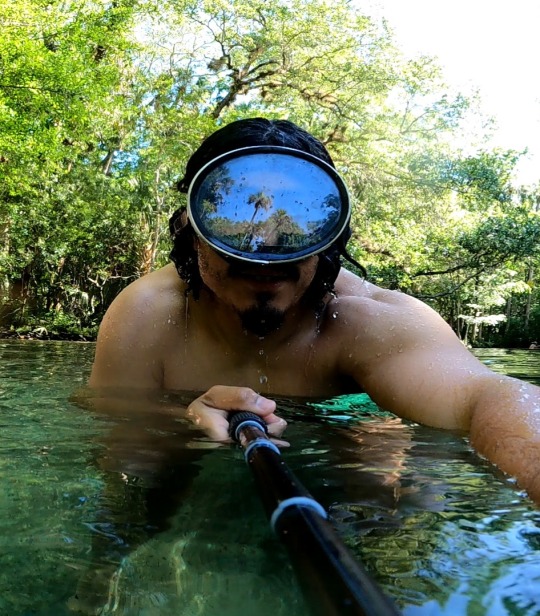
#FloridaSprings#FloridaTravel#Summer#CentralFlorida#SummerActivities#ShadesOfBlue#PureFL#RealFlorida
1 note
·
View note
Text
Celebrating Ichetucknee Spring
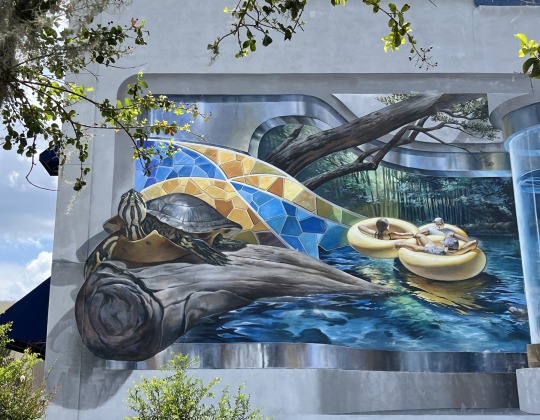
View On WordPress
0 notes
Text
Best spots for kayaking in the Sunshine State
Hop in your kayak and explore some of Florida’s most beautiful springs! 🌊 From crystal clear waters to lush vegetation and wildlife, you’ll get a unique experience each time.
We've rounded up the best spots for kayaking in the Sunshine State - 🗺 including where to go, when to go, and some useful tips.
Hit the water this weekend and explore all that nature has to offer! 🤗
0 notes